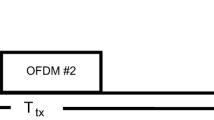Abstract
This paper investigates the performance of orthogonal frequency division multiplexing (OFDM) with \(\pi /4\)-differential quadrature phase shift keying (\(\pi /4\)-DQPSK) modulation, over underwater acoustic (UWA) channels. The orthogonal multicarrier scheme with non-coherent detection technique results in spectrally efficient, reliable and simple receiver design. \(\pi /4\)-QPSK has less envelop fluctuation and performs better in multipath UWA channels. It is shown that with a pair of hydrophones for reception and maximum-ratio combining (MRC) technique, one can achieve considerably low bit-error-rate (BER) at practical signal-to-noise ratio (SNR) value. Further, the BER expression for such a scheme is obtained by using the probability density function and is shown to consist of a series with fast converge rate. The series solution approximation provides a reasonable match between the simulation and the analytical results with and without the MRC diversity technique.













Similar content being viewed by others
References
Akaiwa, Y., & Nagata, Y. (1987). Highly efficient digital mobile communications with a linear modulation method. IEEE Journal on Selected Areas in Communications, 5(5), 890–895.
Chandra, A., & Bose, C. (2008). Analysis of selection combining for differentially detected \(\pi /4\)-DQPSK in Nakagami-m fading channels. In 2008 Annual IEEE India Conference, Kanpur (pp. 317–322). doi:10.1109/INDCON.2008.4768742.
Chandra, A., Mandal, S. C., & Bose, C. (2008). BER of \(\pi /4\)-DQPSK with multichannel reception: Some series solutions. In TENCON 2008-2008 IEEE Region 10 Conference, Hyderabad (pp. 1–6). doi:10.1109/TENCON.2008.4766489.
Chandra, A., & Bose, C. (2010). BER of differentially detected \(\pi /4\)-DQPSK with selection combining in nakagami-m fading. International Journal of Wireless Information Networks, 17(1), 54–63.
Chennakeshu, S., & Saulnier, G. (1993). Differential detection of \(\pi /4\)-shifted-DQPSK for digital cellular radio. IEEE Transactions on Vehicular Technology, 42(1), 46–57.
Kumar, P., & Kumar, P. (2015). A comparative study of spread OFDM with transmit diversity for underwater acoustic communications. Wireless Personal Communications, 83(1), 69–86.
Kumar, P., Trivedi, V. K., & Kumar, P. (2015). Performance evaluation of DQPSK OFDM for underwater acoustic communications. In Underwater Technology (UT), IEEE, Chennai (pp. 1–6). doi:10.1109/UT.2015.7108219.
Li, B., Zhou, S., Stojanovic, M., Freitag, L., & Willett, P. (2008). Multicarrier communication over underwater acoustic channels with nonuniform doppler shifts. IEEE Journal of Oceanic Engineering, 33(2), 198–209.
Miller, M. E., & Lee, J. S. (1998). BER expressions for differentially detected \(\pi /4\) DQPSK modulation. IEEE Transactions on Communications, 46(1), 71–81.
Otnes, R., Asterjadhi, A., Casar, P., Goetz, M., Husy, T., Nissen, I., et al. (2012). Underwater acoustic networking techniques, briefs in electrical and computer engineering. New York: Springer.
Proakis, J. G., Sozer, E. M., Rice, J. A., & Stojanovic, M. (2001). Shallow water acoustic networks. IEEE Communications Magazine, 39(11), 114–1191.
Simon, M. K., & Alouini, M. S. (2003). Some new results for integrals involving the generalized marcum Q function and their application to performance evaluation over fading channels. IEEE Transactions on Wireless Communications, 2(4), 611–615.
Simon, M. K., & Alouini, M. S. (2005). Digital Communication over fading Channels (2nd ed.). New York: Wiley.
Stojanovic, M., & Preisig, J. (2009). Underwater acoustic communication channels: Propagation models and statistical characterization. IEEE Communications Magazine, 47(1), 84–89.
Stojanovic, M. (2005). Retrofocusing techniques for high rate acoustic communications. The Journal of the Acoustical Society of America, 117(3), 1173–1185.
Tan, P., & Beaulieu, N. C. (2007). Precise BER analysis of \(\pi /4\)-DQPSK OFDM with carrier frequency offset over frequency selective fast fading channels. IEEE Transactions on Wireless Communications, 6(10), 3770–3780.
Vajapeyam, M., Vedantam, S., Mitra, U., Preisig, J. C., & Stojanovic, M. (2008). Distributed space time cooperative schemes for underwater acoustic communications. IEEE Journal of Oceanic Engineering, 33(4), 489–501.
Xiong, F. (2006). Digital Modulation Techniques (2nd ed.). Norwood, MA, USA: Artech House Inc.
Zielinski, A., Yoon, Y. H., & Wu, L. (1995). Performance analysis of digital acoustic communication in a shallow water channel. IEEE Journal of Oceanic Engineering, 20(4), 293–299.
Author information
Authors and Affiliations
Corresponding author
Rights and permissions
About this article
Cite this article
Kumar, P., Kumar, P. Performance Evaluation of \(\pi /4\)-DQPSK OFDM over Underwater Acoustic Channels. Wireless Pers Commun 91, 1137–1152 (2016). https://doi.org/10.1007/s11277-016-3517-0
Published:
Issue Date:
DOI: https://doi.org/10.1007/s11277-016-3517-0




